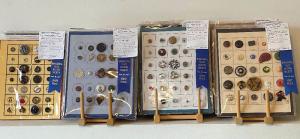Historical Buttons Worth Big Bucks
 ✖  |
Merry Jo Thoele remembers dumping out containers of buttons and playing with them when she was a kid. Overall buttons and work clothes buttons were especially fun. Now the Minnesota State Button Society Editor has a spare bedroom overflowing with buttons organized in containers and mounted on 9 by 12 cards for presentations and competitions.
“With buttons you see the history of art, industry, manufacturing and fashion,” Thoele says.
Styles are endless, from technology that allowed black glass to be mass produced to make buttons for common folks to follow Queen Victoria’s fashion to sturdy, utilitarian china buttons (1840-1930s) made by pressing into molds for everyday work clothing. She even has buttons from Colt, the firearms company, made in the 1920s to 1950s.
“One of the ways to tell the age of buttons is to look on back of the button. Older buttons often have metal shanks embedded into the glass; modern glass buttons are usually self-shanked because they were molded all at once,” Thoele says. She adds that prices for individual collectible buttons are not as high as they were 15 years ago. The Colt or Synthetics Plastic Corp. buttons are worth $2 or $3 each, for example.
“My grandmother would be shocked to know how some buttons are sought by collectors,” laughs Thoele. She recalls that her grandfather saved his mother’s button collection when the family moved from Iowa to Minnesota during a grasshopper infestation. Thoele’s grandmother wasn’t impressed with the “work clothes” buttons (china) and gave many of them away. Thoele has since gotten many of them back.
Besides inheriting her family’s collection, over the years she has purchased valuable and unusual buttons ($50 and up) such as a couple of 18th century habitat buttons from the late 1700s. The 1 1/2-in buttons have real seeds, bugs and grasses mounted on mica covered with a glass dome and sealed with a brass rim. Habitat buttons can be worth as much as $1,000.
For Thoele, collecting buttons is a lifelong hobby, inspired by her grandmother’s mantra that everyone should have a hobby to stay engaged in continuous learning. She is always on the lookout for more buttons and enjoys networking with members of the Minnesota organization (organized in 1943) as well as the National Button Society, which has groups in 39 states and four continents. Members typically meet monthly in her Minnesota group, but recently have been meeting virtually.
“Buttons are really fascinating. And at least they are small,” Thoele laughs, noting her “small” collection has taken over her spare bedroom and spread to the big table in the family room.
Contact: FARM SHOW Followup, Merry Jo Thoele, mjthoele@gmail.com; Minnesota State Button Society, www.mnbuttonsociety.com; National Button Society, www.nationalbuttonsociety.org.

Click here to download page story appeared in.
Click here to read entire issue
Historical Buttons Worth Big Bucks FARM HOME recreation Merry Jo Thoele remembers dumping out containers of buttons and playing with them when she was a kid Overall buttons and work clothes buttons were especially fun Now the Minnesota State Button Society Editor has a spare bedroom overflowing with buttons organized in containers and mounted on 9 by 12 cards for presentations and competitions “With buttons you see the history of art industry manufacturing and fashion ” Thoele says Styles are endless from technology that allowed black glass to be mass produced to make buttons for common folks to follow Queen Victoria’s fashion to sturdy utilitarian china buttons 1840-1930s made by pressing into molds for everyday work clothing She even has buttons from Colt the firearms company made in the 1920s to 1950s “One of the ways to tell the age of buttons is to look on back of the button Older buttons often have metal shanks embedded into the glass; modern glass buttons are usually self-shanked because they were molded all at once ” Thoele says She adds that prices for individual collectible buttons are not as high as they were 15 years ago The Colt or Synthetics Plastic Corp buttons are worth $2 or $3 each for example “My grandmother would be shocked to know how some buttons are sought by collectors ” laughs Thoele She recalls that her grandfather saved his mother’s button collection when the family moved from Iowa to Minnesota during a grasshopper infestation Thoele’s grandmother wasn’t impressed with the “work clothes” buttons china and gave many of them away Thoele has since gotten many of them back Besides inheriting her family’s collection over the years she has purchased valuable and unusual buttons $50 and up such as a couple of 18th century habitat buttons from the late 1700s The 1 1/2-in buttons have real seeds bugs and grasses mounted on mica covered with a glass dome and sealed with a brass rim Habitat buttons can be worth as much as $1 000 For Thoele collecting buttons is a lifelong hobby inspired by her grandmother’s mantra that everyone should have a hobby to stay engaged in continuous learning She is always on the lookout for more buttons and enjoys networking with members of the Minnesota organization organized in 1943 as well as the National Button Society which has groups in 39 states and four continents Members typically meet monthly in her Minnesota group but recently have been meeting virtually “Buttons are really fascinating And at least they are small ” Thoele laughs noting her “small” collection has taken over her spare bedroom and spread to the big table in the family room Contact: FARM SHOW Followup Merry Jo Thoele mjthoele@gmail com; Minnesota State Button Society www mnbuttonsociety com; National Button Society www nationalbuttonsociety org
To read the rest of this story, download this issue below or click
here to register with your account number.







